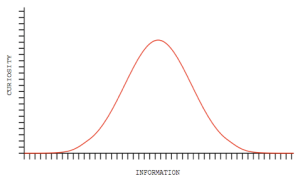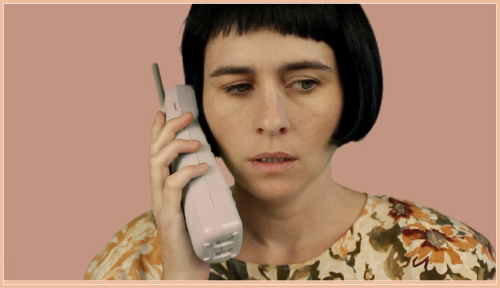…but sets up the conditions necessary for creative production, and by extension the conditions for collaboration and social engagement.” — Anton Vidokle

"Figure 1. Curiosity as a function of information," graph from "Naive Set Theory," by Anthony Humberman, 2007.
Recently a young artist told me he believes Photoshop to be the most elegant synopsis of the process of artmaking and how we learn to use artistic talents. His theory is simple: proficiency breeds reserve. Photoshop is no different – once you become a master, the drop shadow tool becomes less exciting and more vapid. An ideal arts education would foster a student’s proficiency to be reserved. His claim is supported by a hypothetical solution posed by Dexter Sinister to use the Photoshop toolbox as a method for investigating and understanding the historical references and skills behind each tool. Though it is subversive in its re-appropriation of economized technology as the symbol for deeper understandings of art, this method is pedagogically recursive and intellectually emancipating. The opportunity presented to members of the arts community, and arts educators specifically, by incorporating highly conceptual forms and anti-conceptual work into their curriculum to support and motivate students is unprecedented.
Pieces of art theory that traditionally require a history of point and counterpoint can become incredible aphorisms in the modern age to inform the entire spectrum of education. It’s useful to instill in young learners the simple notion that the fixity of meaning can be questioned, or more importantly, that the creation of meaning does not have to take a predetermined form. This suspension of information becomes a part of the new toolbox for a new generation, irrational in everyday representation, but nonetheless informing and influencing the entire schema of thought within each individual.
In order to overcome conceptual alchemy and become a tangible object, art must be surreptitious in its tactics. A derived arts education will not hold up to the Internet and the radically cheapening status of the image. New methods are needed that are flexible and strategic – methods that provide multi-disciplinary, hands on, and truly empowering experiences. By providing a deeply considered program of exhibitions, happenings, experiences, and general chaos that parallels the real life of art, arts educators can help students to better understand the ways in which art can change and manipulate their lives and the world around them.

Corin Hewitt at Western Bridge, Seattle. Part of the New Year Project, 2010.
The benefit of arts education is generally twofold, employing both creative and kinetic practices to broaden a student’s synaptic frontiers. However, many programs make the mistake of setting themselves too far apart from the reality of the art market and process of artmaking. It is easy to point out differences between the practicing art world and the dominant educational model. We are of the opinion that the gallery and the studio play an essential role in arts education. Often, these spaces are more nimble and less controlled and as a result they have an advantage over the sluggish momentum of academic bureaucracy. There must be space within the institutional structure to provide for a variety of experience. A lack of this space is ultimately a lack of tangible experience and ultimately a lack of the “dangerous” ideas that inform the forward progression of art.
As both a process and an outcome, art is inseparable from the people and places where it is displayed, made, bought, performed, or destroyed. To leave this out of an education in the arts is to simply miss the most crucial component of art – experience. Situational understanding is crucial to the dialogic process of education and encourages learners to explore the dynamics between information and curiosity. Unlike the mediated learning space of the classroom, the gallery and studio offer practice-based experiences in the everyday world of art commerce and allow for teachers and learners to explore, replicate, and produce work in a way that is uncompromisingly accountable. If the art community as a whole is committed to improvement, a necessary step will be to energize current practicing artists to pass on their experience to the next generation and beyond. We don’t need everyone to become a professor, but small commitments to conversations, demonstrations, and introductions can make huge leaps in fostering critical minds and advancing interest in the arts. By encouraging collisions with the greater cultural community, students are exposed to non-topical platforms for exchange that expand their edification.
We believe that galleries integrating arts education and programming for patrons of all ages are absolutely necessary to avoid a prolonged cultural drought. So many art practices seem insular and unkind due to a lack of communication between the classroom and the gallery. Making this type of connection becomes crucial to solving a lack of appreciation for arts education and its flaws. Unsurprisingly, the contingent factor in the success of these programs is hard work. It requires artists, educators, and the associated art community to understand that we need relevant, engaging, and intelligent programming, including experiences that are not diluted, controlled, or otherwise mediated by the classroom. Programming that manifests itself as direct exposure to the process and products of art. The stakes are high in the information economy, and cheapening art reduces it to the status of mere image commodity.
Art risks everything if it attempts to dilute itself and ultimately become nothing more than a toolbox of icons. Certainly, we may start from a toolbox, but it’s crucial to dig deep and actually utilize each tool, gain a feel for it and observe its use. We need to be constantly and commandingly producing quality art activities in order to give the next generation the passion and drive they need, and to hone our own skills as well. It doesn’t pay to be alarmist, but the seeming condition of art and art education is grim, leaving one to hope this is the bottom of the curve. To kickstart the art cultural economy, and truly attack the difficulties of engaging different audiences, we need to embrace individual learners and empower students to articulate clearly the conditions and purpose of what they’re dealing with. The conceptual revolution gives arts education the tools to incorporate all learning into art, and further reinforce that learning with art. Harnessing this potential means creating citizens who care about aesthetics and are curious about art, even if they don’t directly participate in its production.
This article was written by both Whitney Ford-Terry and Jessica Powers. The collective will begin as co-curators of the Hedreen Gallery at Seattle University in late July. Programming will start in October.



